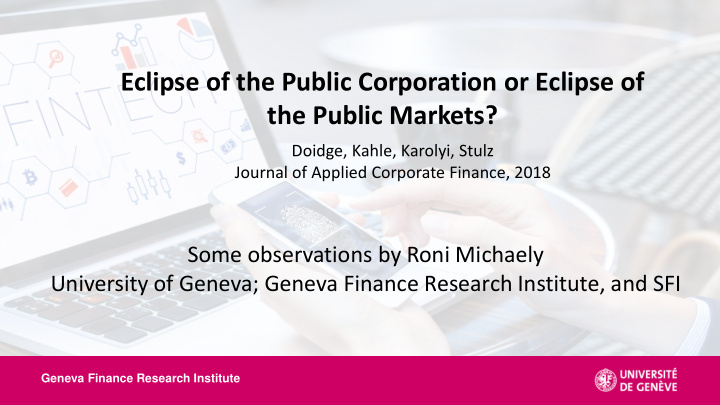



Eclipse of the Public Corporation or Eclipse of the Public Markets? Doidge, Kahle, Karolyi, Stulz Journal of Applied Corporate Finance, 2018 Some observations by Roni Michaely University of Geneva; Geneva Finance Research Institute, and SFI Geneva Finance Research Institute
Are publicly-held corporations in decline? Have they outlived their usefulness? If so, WHY? – Increased agency costs? – Or, perhaps, public markets are an experiment that simply failed—due to conflicts of interest – “U.S. public markets are not well-suited to satisfy the financing needs of young firms with mostly intangible capital” (why? And why now?)
Are public corporations in decline? Yes
The majority of the U.S. industries lost over 50% of their publicly traded peers (Grullon, Larkin, Michaely, 2018)
Is it simply a cyclical phenomenon? (Number of publicly-traded firms over time) Grullon, Larkin, Michaely, 2018
The decline of traded firms is widespread across industries 6
Are public corporations in decline? Not sure
The remaining publicly-traded firms became bigger (in real terms) Grullon, Larkin, Michaely, 2018
The share of public firms out of total sales has remained the same Grullon, Larkin, Michaely, 2018
Same for a subsample of large (over $100m) of firms Grullon, Larkin, Michaely, 2018 10
Clearly fewer smaller (public) firms • WHY? – It’s not about minimum BAS that is too small – It’s not about SOX or Reg FD – Other, cheaper, ways to finance (e.g. VCs, SVB) – More intensive R&D disclosure? (e.g., the impact of the JOBS act ?) – Perhaps it’s not about public markets but about the ability of young, smaller firms to compete
Increased concentration over time (HHI) 12
Increased concentration in most industries in the US This phenomenon is widespread. • • Concentration increased in most industries (3 digit NAICS; 1997 relative to 2014) 13
Increased concentration: The share of the largest 4 firms in the industry has increased (1997 vs 2014) 14
Increased concentration: The share of employment in large firms (10,000+ Employees) has increased 15
Economic Implications: Firms earn higher profits • In each year calculate the percentage change in concentration (e.g., the number of firms relative to the long-term average for each industry) • Rank all the changes (quintiles) • Calculate average change in ROA for each firm/industry/year Aggregate the change in ROA for each quintile. • The increased concentration is associated with increased profitability 16
As industries become more concentrated • Increase in ROA and profit margins (Grullon et al 2018) No increase in efficiency (Grullon et al 2018) • • Increase in concentration of innovation (Grullon et al 2019) • No increase in investment in capital or labor (Barkai 2017, Gutierrez and Philippon 2017), • But increase in payment to shareholders (Barkai 2017) • Increase in ability to ‘squeeze’ labor (BenMelech et al 2018) Increase in value of related mergers (Grullon et al 2018) • • Not unique to public firms
What’s behind it? • Falling enforcement, rising concentrations • Increased barriers to entry
WSJ, June 8 2018
Pizza as an example Big Pizza Chains Use Web Ordering To Slice Out Bigger Market Share; Many Mom-and-Pop Strategic Pizza Infrastructure Goes High-Tech Shops Lack Resources to Compete Online • Smartwatches • Connected cars • Xbox Orders • Retinal scanning • GPS to monitor drivers • 400 tech people @Dominos
Delivery Robot 23
Doidge et al 2018
Conclusions • As always the case with Rene’s papers—I learned a lot. • Full of valuable and interesting facts that challenge our thinking of how (public) financial markets work • Extremely important issue with far-reaching and relevant policy implications
Recommend
More recommend